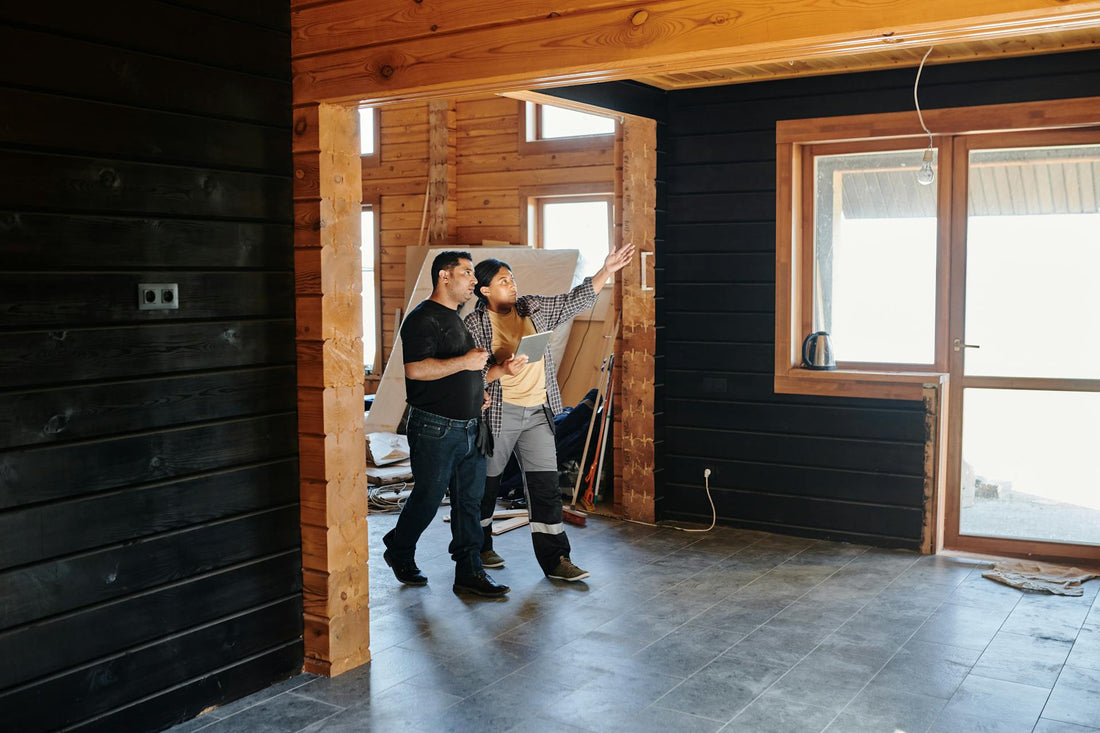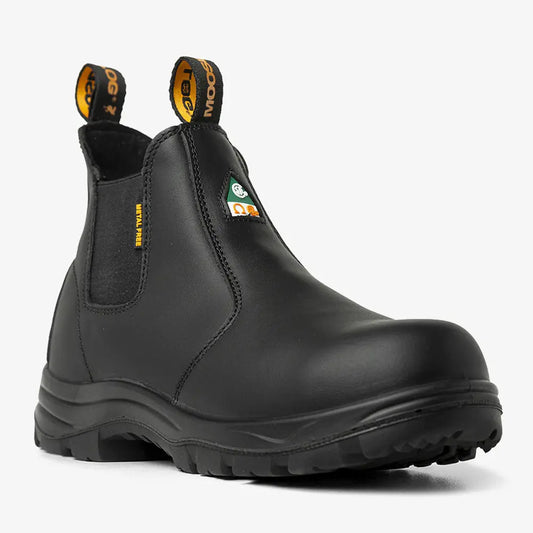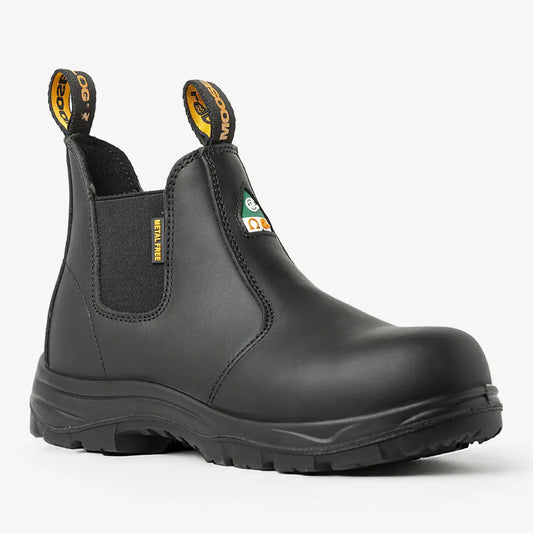
Your Boss Says “OSHA-Approved Boots.” Here’s What That Actually Means
You’ve probably heard someone at work say, “Make sure your boots are OSHA-approved.”
That phrase sounds official, but it’s a misconception. The Occupational Safety and Health Administration (OSHA) does not test, certify, or approve any specific brand or model of protective footwear. Instead, OSHA is the enforcement body, requiring employers to ensure that all personal protective equipment (PPE), including boots, meets strict, independently established consensus safety standards.
For safety footwear in the United States, that standard is typically ASTM F2413. By enforcing compliance with this benchmark, OSHA ensures protection from common workplace hazards, regardless of the brand.
What Are the OSHA Requirements for Work Boots?
The employer’s obligation to provide protective footwear stems from two key OSHA standards:
- 29 CFR 1910.132 (Hazard Assessment): This requires the employer to first assess the workplace to determine if hazards are present (or likely to be present) that necessitate the use of PPE.
- 29 CFR 1910.136 (Foot Protection): If the hazard assessment determines a risk of foot injury from falling/rolling objects, punctures, or electrical hazards, this rule mandates that the footwear used must meet the performance criteria of ASTM F2413-18 or a newer version.
In simple terms, a boot is not "approved," it is compliant once its performance meets the stringent requirements outlined by ASTM testing.
“OSHA recognizes ASTM F2413 as the accepted benchmark for protective footwear. Employers must provide or require shoes that meet this standard.” — U.S. Occupational Safety and Health Administration
Core OSHA Requirements
- Toe protection that resists impact and compression (I/75 C/75)
- Electrical hazard protection or static-dissipative protection when required
- Puncture-resistant plate when sharp objects are present
- Slip-resistant outsole suited to job conditions
Protective footwear is tested for specific hazards and when a boot passes these tests, it’s OSHA-compliant.
How ASTM F2413 Protects You
ASTM F2413 is the performance standard behind every compliant work boot. It sets minimum strength levels for impact, compression, puncture, and electrical protection.
Each certified pair includes a code printed inside the tongue or lining, the code is formatted as follows: ASTM F2413-XX (M/F) I/75 C/75 followed by the specific protective features.

|
Code |
Standard |
Meaning & Protection |
|---|---|---|
|
F2413-XX |
Standard Version |
The year the specification was established (e.g., F2413-18). |
|
M or F |
Gender |
Indicates the last used to size the shoe (M = Male; F = Female). |
|
I/75 |
Impact Resistance |
The highest protection rating. Withstands impact energy of 75 foot-pounds. |
|
C/75 |
Compression Resistance |
The highest protection rating. Withstands compressive loads up to 2,500 pounds. |
|
PR |
Puncture Resistance |
Includes a puncture-resistant plate in the sole. |
|
EH |
Electrical Hazard |
Sole and heel provide secondary protection against electrical shock. |
|
SD |
Static Dissipative |
Reduces excess static electricity by conducting charges to the ground. |
|
MT |
Metatarsal Protection |
Protects the upper foot (metatarsal bones) from impact. |
Safety toes made of steel, aluminum alloy, or composite materials are all fully compliant, provided they meet the I/75 and C/75 performance standards. The material used is irrelevant to compliance; only the performance matters.
CSA Z195: The Canadian Standard

In Canada, CSA Z195-14 defines the performance requirements for protective footwear, addressing the same core hazards as ASTM F2413.
The key difference is that the CSA Group uses easy-to-read, colour coded symbols on the footwear label to denote the type and level of protection, such as that green triangle patch you commonly see:
|
Symbol |
Meaning & Protection |
|---|---|
|
Green Triangle |
Grade 1 Toe and Puncture Protection. The highest level of protection, indicating a steel or composite toe capable of $1.5$ tonne resistance, plus a puncture-resistant sole. |
|
Yellow Triangle |
Grade 2 Toe and Puncture Protection. Medium protection, with toe resistance up to $1.1$ tonne and puncture resistance. |
|
Blue Square |
Grade 1 Toe Protection ONLY. Excellent toe protection, but no puncture-resistant sole. |
|
White Rectangle |
Electrical Shock Resistance (ESR). Provides protection against contact with live electrical conductors. |
|
Yellow Rectangle |
Static Dissipative (SD). Conducts static charge away from the body to the ground. |
|
Red Rectangle |
Conductive (C). Designed to quickly dissipate static charge where explosion risk exists. |
By checking for these specific symbols and codes, workers in Canada can confirm compliance with the local standard just as easily as workers checking the ASTM code in the U.S.
Why “OSHA-Approved” Doesn’t Exist
When someone says “OSHA-approved,” they usually mean “OSHA-compliant.” OSHA never stamps approval on any product. Its job is to enforce the requirement that your boots meet ASTM F2413 testing.
Wearing uncertified boots can lead to two problems: your employer can get fined, and you can get hurt. Always look for the ASTM or CSA code before stepping onto a site.
How to Check If Your Boots Are Compliant
- Read the label inside the tongue or lining.
-
Confirm the code. Example:
ASTM F2413-18 M I/75 C/75 PR EH. - Ignore vague claims like “meets safety standards” without proof.
- Verify certifications on the manufacturer’s site.
- Choose brands that list both ASTM F2413 and CSA Z195 on every product page.
MooseLog and Compliance You Can Count On

Every pair of MooseLog boots is engineered to meet or exceed both ASTM F2413 and CSA Z195 standards, so you never have to guess whether your gear is compliant. From the job site to the warehouse, each component is tested for the same hazards OSHA and CSA target—impact, compression, puncture, and electrical risks.
MooseLog’s difference is their BigZone™ composite toe absorbs heavy impact without adding weight. The Dyna-Flex® composite plate resists punctures from nails or rebar while keeping the sole flexible for long shifts. The SafeTread™ rubber outsole grips concrete, steel, and mud-tested surfaces, giving you dependable traction even when conditions turn slick.
MooseLog focuses on measurable protection. Every pair carries the full ASTM F2413-18 and CSA Z195 labels right in the boot, so inspectors and safety officers can verify compliance instantly.
When your workday depends on meeting OSHA’s standards, choose boots built from the start to pass them.
Shop MooseLog ASTM and CSA-Certified Work Boots
Related Reads
-
Breaking Down ASTM F2413: What Every Worker Should Actually Know
-
8 Best CSA-Approved Work Boots to Buy in 2025
FAQ
1. What are the OSHA requirements for work boots?
Boots must meet ASTM F2413-18 or later for impact, compression, puncture, and electrical protection.
2. Does OSHA approve specific brands or models?
No. OSHA enforces standards but doesn’t certify or endorse footwear.
3. Are composite toe boots OSHA-compliant?
Yes, if they’re tested and certified under ASTM F2413. Composite meets the same safety levels as steel.
4. How do I know if my boots meet ASTM F2413?
Check the inside label. It must clearly list the ASTM F2413 code and protection ratings.
5. What’s the difference between ASTM and CSA?
ASTM covers U.S. standards; CSA covers Canada. Both test for the same core hazards (impact, compression, puncture, electrical).
6. Can my employer require specific brands?
Yes, as long as those brands meet OSHA’s compliance rule through ASTM F2413 certification.






